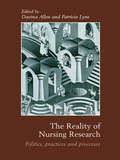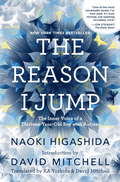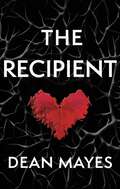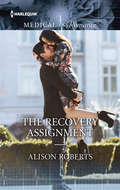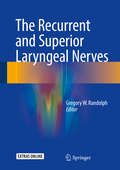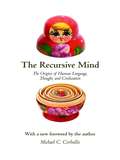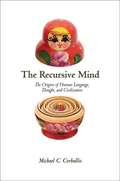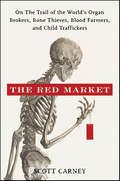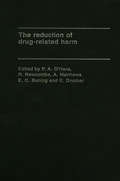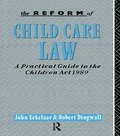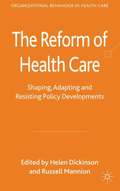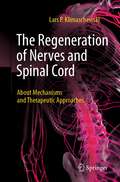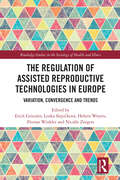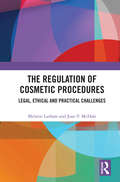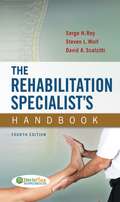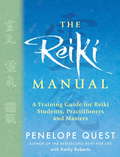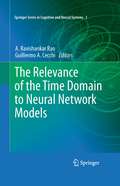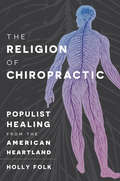- Table View
- List View
The Reality of Nursing Research: Politics, Practices and Processes
by Davina Allen Patricia LyneFocusing on the nurse researcher's dual role as practitioner and researcher, as well as research ethics and the relationship between practitioner and academic agendas, The Reality of Nursing Research helps to: locate the practical dilemmas of nursing research in historical and policy context prepare those about to embark on research for some of the issues they will face reassure researchers that they are not the only ones to encounter the complexity of real life research support the research teacher or supervisor in preparing and mentoring their students share experiences of others who have encountered similar issues and provide some practical advice on their solution. With illustrative case studies and practical advice, this book looks at the real life dilemmas faced by nurse researchers at key stages of the research process from developing a research question through to disseminating the findings. It is an essential text for nurse researchers, teachers of research, research supervisors and nurses undertaking research at diploma through to doctoral level.
The Reason I Jump: The Inner Voice Of A Thirteen-year-old Boy With Autism
by David Mitchell Naoki Higashida Ka YoshidaYou've never read a book like The Reason I Jump. Written by Naoki Higashida, a very smart, very self-aware, and very charming thirteen-year-old boy with autism, it is a one-of-a-kind memoir that demonstrates how an autistic mind thinks, feels, perceives, and responds in ways few of us can imagine. Parents and family members who never thought they could get inside the head of their autistic loved one at last have a way to break through to the curious, subtle, and complex life within. <p><p> Using an alphabet grid to painstakingly construct words, sentences, and thoughts that he is unable to speak out loud, Naoki answers even the most delicate questions that people want to know. Questions such as: "Why do people with autism talk so loudly and weirdly?" "Why do you line up your toy cars and blocks?" "Why don't you make eye contact when you're talking?" and "What's the reason you jump?" (Naoki's answer: "When I'm jumping, it's as if my feelings are going upward to the sky.") With disarming honesty and a generous heart, Naoki shares his unique point of view on not only autism but life itself. His insights--into the mystery of words, the wonders of laughter, and the elusiveness of memory--are so startling, so strange, and so powerful that you will never look at the world the same way again. <p> In his introduction, bestselling novelist David Mitchell writes that Naoki's words allowed him to feel, for the first time, as if his own autistic child was explaining what was happening in his mind. "It is no exaggeration to say that The Reason I Jump allowed me to round a corner in our relationship." This translation was a labor of love by David and his wife, KA Yoshida, so they'd be able to share that feeling with friends, the wider autism community, and beyond. Naoki's book, in its beauty, truthfulness, and simplicity, is a gift to be shared.
The Rebel Surgeon's Proposal
by Margaret McdonaghNicknamed "the ice maiden," Francesca Scott has kept men at arm's length--ever since bad-boy Luke Devlin walked out of her life.Tarnished by the reputation of his family, Luke left Strathlochan for a fresh start. Now a surgeon, he's back and determined to put his rebellious past behind him. But a chance meeting with Francesca sparks old feelings, and Luke realizes this beautiful woman is the best thing that ever happened to him. Now more than anything else, Luke is determined to make Francesca his bride once and for all!
The Recipient: A Pyschological Medical Thriller
by Dean MayesHer heart is dying.Casey Schillinge is a vivacious young woman on the verge of making her mark on the world. While backpacking, she is struck down by a tropical disease and suffers cardiac failure. But at the eleventh hour, Casey receives a life-saving heart transplant and a rare second chance to begin again.Her new heart is changing her.Three years later, Casey has become a withdrawn shell of her former self: she is estranged from her loved ones, afraid of open spaces and rides the line between legitimate and criminal work. The worst of her troubles come in the form of violent night terrors; so frightening that she resorts to extreme measures to keep herself from sleeping.What is her heart revealing?When she can take no more, she embarks on a desperate search for the source of her dreams. In so doing, she makes a shocking discovery surrounding the tragic fate of the donor whose heart now beats inside her chest. As she delves deeper into the mystery of her donor, she realizes her dreams are not a figment of her imagination, but a real-life nightmare.Will her heart end up killing her after all?"As Dean takes you on an adrenaline-fuelled ride that twists to a kicker of a climax, ultimately uncovering a tale of human horror that is all too real, he will keep you guessing throughout as you try and figure out just who the good guys and the bad guys are. A word of warning – trust no-one as you race towards the very satisfying conclusion of this gripping psychological thriller!" - Marcia B, Book Muster Down Under"Entwining very real social issues with fast-paced adventure and fascinating dream sequences, Mayes has created a story that successfully combines suspense, dark humor, cultural references, action and outright horror, an intense examination of what motivates the terrible crimes perpetrated in the novel. Be prepared for a wild ride!" - Abbie Williams, author of The Shore Leave Cafe series"Overall, a great read that was fascinating medically and had great character development." - Christina Boswell, Manhattan Book ReviewBe sure to also read Dean Mayes' other novels:The Hambledown DreamGifts of the PeramangkThe Artisan Heart
The Recovery Assignment
by Alison RobertsWorking partners--up close and personal! Officer Owen Hawkins of the Serious Crash Squad is furious to be assigned Charlotte Laing as his new partner. He wanted a dedicated police officer--not a paramedic! And it won't help that he finds her disturbingly attractive... But Charlotte is very clear that the attraction isn't going anywhere. She's done love--never again. This assignment is about work. Soon they are the best team around and, despite Charlotte's claims, the chemistry between them is out of control. Is Owen the man who can mend her wounded heart?
The Recurrence of COVID-19 in New York State and New York City: Surfing the Second Wave (SpringerBriefs in Public Health)
by Rodrick Wallace Deborah WallaceAs a follow-up to COVID-19 in New York City: an Ecology of Race and Class Oppression, which showed that decades of discriminatory public policies shaped the Bronx into the epicenter of the first wave of COVID-19, this book examines the build up to the crest and subsequent ebbing of the second wave of COVID-19 across the 62 counties of New York State (NYS) and 152 ZIP Code areas of the four central boroughs of New York City (NYC). Like its predecessor, the sequel examines the vulnerabilities that give rise to spikes in infection rates that form epicenters. Unlike the first wave, NYC was not the epicenter of the second wave; high-incident counties just outside NYS formed an extended initial epicenter and exported COVID-19 to neighboring counties of NYS. Rural NYS counties differed significantly from urban ones socioeconomically and in infection rates during the cresting period. Before the crest, no socioeconomic factor was associated with county infection rates; rather, the major associating factor was political and cultural: percent of the 2020 vote garnered by Trump. Rural counties voted heavily for Trump. This association disappeared post-crest by mid-January 2021. In NYC, the Bronx again behaved like a single high-incidence entity, unlike the other three boroughs that had patches of high and low infection incidence. Among the topics covered:The Second COVID Wave Washes Over New York StateThe Second Wave Storm-Surges Across New York CityDiscussion of County Data from the Second Wave of COVID-19Parsing Meaning From the 152 ZIP Code Data The book closes with a prescription for pandemic response planning based on empowered communities and workers interacting with health departments as equals. The Recurrence of COVID-19 in New York State and New York City is a valuable resource for social epidemiologists, public health researchers of health disparities, those in public service tasked with addressing these problems, and infectious disease scientists who focus on spread in human populations of new zoonotic diseases. The brief also will find readership among students in these fields, civil rights scholars, science writers, medical anthropologists and sociologists, medical and public health historians, public health economists, and public policy scientists.
The Recurrent and Superior Laryngeal Nerves
by Gregory W. RandolphThis textbook is designed to deliver a comprehensive up-to-date review of all aspects of recurrent laryngeal nerve and superior laryngeal nerve anatomy including surgically important anatomy, key strategic surgical maneuvers, state-of-the-art neural monitoring, preservation of recurrent and superior laryngeal nerves during thyroidectomy and surgical management. Presently, there is no other single book available, that includes all of these surgically important topics explicitly and in-depth. The book is visually oriented with color illustrations and photomicrographs embracing all aspects of recurrent laryngeal nerve anatomy including branching patterns, relationship of the nerve and the inferior thyroid artery and the non-recurrent recurrent laryngeal nerve. A new classification system for recurrent laryngeal nerve anatomy is proposed. Intraoperative neural monitoring of the nerves is also covered in detail along with new horizons and encompass a practical approach to neural monitoring right from set up, actual monitoring and clinical relevance and usefulness of the monitoring data in making surgical decisions. The current status of the field is summarized and placed in context with optimal surgical management of these nerves. All chapters are written by world class US and International experts in anatomy, surgery and nerve monitoring. The Recurrent and Superior Laryngeal Nerves will be of great value to Otolaryngologists and General Surgeons, Endocrine Surgeons, Fellows in Endocrine, Head and Neck Surgery, General Surgery and Otolaryngology residents.
The Recursive Mind
by Michael C. CorballisThe Recursive Mind challenges the commonly held notion that language is what makes us uniquely human. In this compelling book, Michael Corballis argues that what distinguishes us in the animal kingdom is our capacity for recursion: the ability to embed our thoughts within other thoughts. "I think, therefore I am," is an example of recursive thought, because the thinker has inserted himself into his thought. Recursion enables us to conceive of our own minds and the minds of others. It also gives us the power of mental "time travel"--the ability to insert past experiences, or imagined future ones, into present consciousness. Drawing on neuroscience, psychology, animal behavior, anthropology, and archaeology, Corballis demonstrates how these recursive structures led to the emergence of language and speech, which ultimately enabled us to share our thoughts, plan with others, and reshape our environment to better reflect our creative imaginations. He shows how the recursive mind was critical to survival in the harsh conditions of the Pleistocene epoch, and how it evolved to foster social cohesion. He traces how language itself adapted to recursive thinking, first through manual gestures, then later, with the emergence of Homo sapiens, vocally. Toolmaking and manufacture arose, and the application of recursive principles to these activities in turn led to the complexities of human civilization, the extinction of fellow large-brained hominins like the Neandertals, and our species' supremacy over the physical world.Some images inside the book are unavailable due to digital copyright restrictions.
The Recursive Mind: The Origins of Human Language, Thought, and Civilization
by Michael C. CorballisThe Recursive Mind challenges the commonly held notion that language is what makes us uniquely human. In this compelling book, Michael Corballis argues that what distinguishes us in the animal kingdom is our capacity for recursion: the ability to embed our thoughts within other thoughts. "I think, therefore I am," is an example of recursive thought, because the thinker has inserted himself into his thought. Recursion enables us to conceive of our own minds and the minds of others. It also gives us the power of mental "time travel"--the ability to insert past experiences, or imagined future ones, into present consciousness.Drawing on neuroscience, psychology, animal behavior, anthropology, and archaeology, Corballis demonstrates how these recursive structures led to the emergence of language and speech, which ultimately enabled us to share our thoughts, plan with others, and reshape our environment to better reflect our creative imaginations. He shows how the recursive mind was critical to survival in the harsh conditions of the Pleistocene epoch, and how it evolved to foster social cohesion. He traces how language itself adapted to recursive thinking, first through manual gestures, then later, with the emergence of Homo sapiens, vocally. Toolmaking and manufacture arose, and the application of recursive principles to these activities in turn led to the complexities of human civilization, the extinction of fellow large-brained hominins like the Neandertals, and our species' supremacy over the physical world.
The Red Market: On the Trail of the World's Organ Brokers, Bone Thieves, Blood Farmers, and Child Traffickers
by Scott Carney“An unforgettable nonfiction thriller, expertly reported….A tremendously revealing and twisted ride, where life and death are now mere cold cash commodities.”—Michael Largo, author of Final ExitsAward-winning investigative journalist and contributing Wired editor Scott Carney leads readers on a breathtaking journey through the macabre underworld of the global body bazaar, where organs, bones, and even live people are bought and sold on The Red Market. As gripping as CSI and as eye-opening as Mary Roach’s Stiff, Carney’s The Red Market sheds a blazing new light on the disturbing, billion-dollar business of trading in human body parts, bodies, and child trafficking, raising issues and exposing corruptions almost too bizarre and shocking to imagine.
The Reduction of Drug-Related Harm
by P. A. O’Hare R. Newcombe A. Matthews E. C. Buning E. DruckerFirst Published in 1992. Routledge is an imprint of Taylor & Francis, an informa company.
The Reform of Child Care Law: A Practical Guide to the Children Act 1989
by Robert Dingwall John EekelaarChildren Act 1989 introduced the most radical changes to child care law for a generation. Eekelaar and Dingwall provide a concise, practical guide to the legislation for all professionals practising in this area.
The Reform of Health Care
by Helen Dickinson Russell MannionThis book examines how healthcare organisations shape, adapt and resist developments in healthcare policy and practice. This is an international text bringing together contributions from around the globe and covers a wide range of different discussions in relation to the policy/practice gap.
The Regeneration of Nerves and Spinal Cord: About Mechanisms and Therapeutic Approaches
by Lars P. KlimaschewskiThis non-fiction book provides information about the latest findings on research and therapy of nerve regeneration with catchy drawings and in understandable words. Why do nerves in the extremities regenerate, but the axons in the spinal cord do not? Can transplanted stem cells or biopolymers restore regeneration? Are bioprostheses able to functionally replace amputated arms or legs? Neuroscientist Lars Klimaschewski answers these questions and reports on exciting findings from anatomy, cell and molecular biology and neurotechnology. Find out, among other things, how a brain-computer interface processes signals from the brain in order to control the arm or leg muscles again via electrodes after a paraplegia.The translation was done with the help of artificial intelligence. A subsequent human revision was done primarily in terms of content.
The Registrar's Wedding Wish
by Lucy ClarkA knight in Geelong GeneralAnnie Beresford is a talented surgeon and trainee consultant. But her wish is for marriage and children before it's too late. She knows she's vulnerable, and that falling for Hayden Robinson, her new boss, is a bad idea. But this man might just be the one!Hayden rescues her more than once, and his desire for her is clear, but after one failed marriage he'd rather focus on saving lives. So Annie must help her reluctant knight because she comes to realize they can't be happy without each other--even if he won't believe her yet!
The Regulation of Animal Health and Welfare: Science, Law and Policy (Law, Science and Society)
by Wyn Grant John McEldowney Graham MedleyThe Regulation of Animal Health and Welfare draws on the research of scientists, lawyers, economists and political scientists to address the current and future regulatory problems posed by the issues of animal health and disease. Recent events such as the outbreak of mad cow disease, epidemics of foot and mouth disease, concerns about bluetongue in sheep, and the entry into the food chain of the offspring of cloned cattle, have heightened awareness of the issues of regulation in animal disease and welfare. This book critically appraises the existing regulatory institutions and guiding principles of how best to maintain animal health in the context of social change and a developing global economy. Addressing considerations of sound science, the role of risk management, and the allocation of responsibilities, it also takes up the theoretical and practical challenges which here – and elsewhere – attend the co-operation of scientists, social scientists, lawyers and policy makers. Indeed, the collaboration of scientists and social scientists in determined and regulatory contexts such as that of animal disease is an issue of ever-increasing importance. This book will be of considerable value to those with interests in this issue, as well as those concerned with the law and policy relating to animal health and welfare.
The Regulation of Assisted Reproductive Technologies in Europe: Variation, Convergence and Trends
by Heleen Weyers Nicolle Zeegers Erich Griessler Florian Winkler Lenka SlepičkováThis book explores the social, ethical and legal implications of assisted reproductive technologies (ART). Providing a comparative analysis of several European countries, the authors evaluate the varied approaches to the application of ART throughout Europe. From a global perspective, countries take very different approaches to the regulation of ART. Countries apply restrictions to the access criteria for these treatments and/or direct restrictions to the practice of the techniques themselves. To understand these varied approaches to ART practice and regulation, it is necessary to understand the societal and political background from which they emerged. This book therefore consists of case studies from eight European countries which provide insights into the status and development of the regulation of ART in the last 40 years. The country cases from all over Europe and the three comparative chapters provide insights into the diversity of current ART regulation across the continent as well as into similarities, differences and trends in this regulatory area. This book will be of interest to practitioners of ART who are interested in understanding the differences in regulation of ART in Europe, as well as long-term trends in this respect. Given the ethical and legal implications the book explores, it will also be of interest to students or researchers in the fields of social sciences, humanities and law.
The Regulation of Cosmetic Procedures: Legal, Ethical and Practical Challenges
by Jean Mchale Melanie LathamThis book examines the ethical and regulatory debates surrounding the rise of the cosmetic procedures industry. In the past, cosmetic procedures were often seen as limited to a small number of wealthy older women. Today, such procedures have gone mainstream, partly facilitated by the rise of "non-invasive" techniques, such as the use of Botox and Dermal Fillers. While still a business dominated by the female consumer, there are also an increasing number of males undertaking cosmetic procedures as social expectations around appearance and ageing are challenged. At the same time, the rapid expansion of this business, and the incoherent, diverse approach to its regulation, have given rise to concern. It has been seen as a "Wild West". If cosmetic procedures go wrong, such procedures give rise to real risks of harm. This book examines the historical backdrop, current practice and risks associated with cosmetic procedures. It discusses the ethical and regulatory challenges for this area. It also examines the current legal frameworks concerning people, practitioners and products in the UK. The book also draws lessons from regulatory approaches in other jurisdictions with particular reference to the United States, Brazil and France. It then sets out a legal and regulatory framework that might better protect and empower the cosmetic consumer, now and in the future. The book is likely to be of particular interest to those working in the areas of health and medical law, socio-legal studies and political science.
The Regulation of Medical Products: Dope, Drugs and Devices (Law, Science and Society)
by Penny GleesonThis book develops a theoretical framework for examining and assessing the regulatory arrangements for medical products.Since the first half of the 20th century, the regulation of pharmaceuticals, medical devices and, more recently, biologicals have been controlled in many jurisdictions by specific regulatory regimes and agencies. Their regulatory mandates are similar – to ensure the quality, safety and efficacy of medical products. This book provides a timely and relevant assessment of the complexities of medical regulatory regimes, by drawing on a particular theory of political legitimacy. In this respect, the book adopts a ‘dialogic’ approach – according to which a shared set of normative beliefs and values are formulated – as a theoretical ‘tool’ to identify deficiencies in the regulatory arrangements for medical products. Drawing on several Australian cases studies, characterised by divergent normative perspectives, the book develops its dialogic approach in order to challenge the usual legitimation of regulatory regimes from the perspective of science alone. Specifically, it maintains that such regimes need to embrace a normative pluralism that admits a diversity of types and sources of knowledge.This evaluation of the increasingly influential domain of medical regulation will appeal to a range of scholars and practitioners working in law, public health, politics and science and technology studies.
The Rehabilitation Specialist's Handbook (Fourth Edition)
by Serge H. Roy Steven L. Wolf David A. ScalzittiThe 4th Edition of the gold standard of rehabilitation resources is now in full color and thoroughly revised and updated to reflect the art and science of practice today! A compendium of frequently used, but rarely memorized information organized for easy reference, it covers an extraordinary breadth of topics--from the full range of basic scientific information (neuroanatomy and clinical neurology, osteology and clinical orthopedics, general anatomy, cardiac and pulmonary anatomy) to the treatments and methods used in modern rehabilitation practice. With its outcome and evidence-based focus and several expert contributors, this text is a must for PT's at any stage in their career.
The Reiki Manual: A Training Guide for Reiki Students, Practitioners and Masters
by Penelope Quest Kathy RobertsReiki is a holistic system for balancing, healing and harmonising all aspects of the person - body, mind, emotions and spirit - encouraging deep relaxation and the release of stress and tension, and promoting awareness and spiritual growth. This comprehensive manual provides much-needed support for students and teachers who want to ensure best practice. It can also be used by people who have taken Reiki courses and want more information, or wish to update their skills and work professionally, or simply treat themselves, family and friends informally. The first three sections cover levels Reiki 1, Reiki 2 and Reiki 3. Information is given in an accessible, structured and interactive way to increase understanding, knowledge and experience. The final section of the manual contains reference material specifically for students who wish to become professional practitioners, and for Masters who wish to expand the scope of the training they can offer to their students. This final section also provides the foundation for additional courses or workshops on topics such as health and safety and managing a successful practice.
The Relation between Physical and Mental Illness: The Physical Status of Psychiatric Patients at a Multiphasic Screening Survey
by Michael EastwoodThe relation between mind and body has been keen of interest since antiquity. The author surveys the approaches to the subject from the observational to the experimental level. He presents the findings of a study carried out, at a community health screening survey, to test the association between physical and psychiatric disorder. The methodological difficulties of this kind of study, such as sampling the general population and reliable measurement of clinical states, are described. The results of the study, which confirm the two types of morbidity have a positive and significant association, are discussed in terms of the ecology of disease and psychosomatic medicine. It is suggested that the findings have implications for the delivery of health care and preventive medicine.
The Relaxation Response
by Herbert BensonWhen Dr. Herbert Benson introduced this simple, effective, mind/body approach to relieving stress twenty-five years ago, his book became an instant national bestseller. Since that time, millions of people have learned the secret--without high-priced lectures or prescription medicines. The Relaxation Response has become the classic reference recommended by most health care professionals and authorities to treat the harmful effects of stress. Discovered by Dr. Benson and his colleagues in the laboratories of Harvard Medical School and its teaching hospitals, this revitalizing, therapeutic approach is now routinely recommended to treat patients suffering from heart conditions, high blood pressure, chronic pain, insomnia, and many other physical ailments. It requires only minutes to learn, and just ten to twenty minutes of practice twice a day.
The Relevance of the Time Domain to Neural Network Models
by Guillermo A. Cecchi A. Ravishankar RaoA significant amount of effort in neural modeling is directed towards understanding the representation of information in various parts of the brain, such as cortical maps [6], and the paths along which sensory information is processed. Though the time domain is integral an integral aspect of the functioning of biological systems, it has proven very challenging to incorporate the time domain effectively in neural network models. A promising path that is being explored is to study the importance of synchronization in biological systems. Synchronization plays a critical role in the interactions between neurons in the brain, giving rise to perceptual phenomena, and explaining multiple effects such as visual contour integration, and the separation of superposed inputs. The purpose of this book is to provide a unified view of how the time domain can be effectively employed in neural network models. A first direction to consider is to deploy oscillators that model temporal firing patterns of a neuron or a group of neurons. There is a growing body of research on the use of oscillatory neural networks, and their ability to synchronize under the right conditions. Such networks of synchronizing elements have been shown to be effective in image processing and segmentation tasks, and also in solving the binding problem, which is of great significance in the field of neuroscience. The oscillatory neural models can be employed at multiple scales of abstraction, ranging from individual neurons, to groups of neurons using Wilson-Cowan modeling techniques and eventually to the behavior of entire brain regions as revealed in oscillations observed in EEG recordings. A second interesting direction to consider is to understand the effect of different neural network topologies on their ability to create the desired synchronization. A third direction of interest is the extraction of temporal signaling patterns from brain imaging data such as EEG and fMRI. Hence this Special Session is of emerging interest in the brain sciences, as imaging techniques are able to resolve sufficient temporal detail to provide an insight into how the time domain is deployed in cognitive function. The following broad topics will be covered in the book: Synchronization, phase-locking behavior, image processing, image segmentation, temporal pattern analysis, EEG analysis, fMRI analyis, network topology and synchronizability, cortical interactions involving synchronization, and oscillatory neural networks. This book will benefit readers interested in the topics of computational neuroscience, applying neural network models to understand brain function, extracting temporal information from brain imaging data, and emerging techniques for image segmentation using oscillatory networks
The Religion of Chiropractic: Populist Healing from the American Heartland
by Holly FolkChiropractic is by far the most common form of alternative medicine in the United States today, but its fascinating origins stretch back to the battles between science and religion in the nineteenth century. At the center of the story are chiropractic's colorful founders, D. D. Palmer and his son, B. J. Palmer, of Davenport, Iowa, where in 1897 they established the Palmer College of Chiropractic. Holly Folk shows how the Palmers' system depicted chiropractic as a conduit for both material and spiritualized versions of a "vital principle," reflecting popular contemporary therapies and nineteenth-century metaphysical beliefs, including the idea that the spine was home to occult forces.The creation of chiropractic, and other Progressive-era versions of alternative medicine, happened at a time when the relationship between science and religion took on an urgent, increasingly competitive tinge. Many remarkable people, including the Palmers, undertook highly personal reinterpretations of their physical and spiritual worlds. In this context, Folk reframes alternative medicine and spirituality as a type of populist intellectual culture in which ideologies about the body comprise a highly appealing form of cultural resistance.
